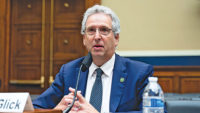Ian P. Tyler, a chartered accountant who now runs London-based contractor Balfour Beatty plc, admits to “never being good” at the accounting business. But the company’s CEO is much better at the numbers game than he lets on, having propelled it in the last decade to become a diversified and profitable construction industry player.
With the $626-million addition of professional services heavyweight Parsons Brinckerhoff (PB), New York City, in 2009, the firm now aims to expand its global footprint and capitalize on its resources. The combination already is generating a new competitive force, as the firms work to take advantage of what each has gained in more than a century of operation and to bridge cultural differences quickly amid growing market pressures.
If the publicly owned Balfour Beatty’s (BB) latest numbers are any indication, the firms are well on their way. In its first major results report (released on Aug. 11) since acquiring PB last October, the contractor said that, for the first half of 2010 ending on June 26, company revenue totaled, even with decreases in some markets, close to $7.2 billion, up from $6.8 billion in the same period a year earlier.
Pre-tax profit rose 32%, while earnings per share went up 4%. PB contributed $54 million of the $76-million profit total reported in the professional services unit, which BB says “is ahead of plan.” Backlog rose to $22.7 billion, up nearly $700 million since the end of 2009.
But looming cuts in the U.K. public- sector market, which fuels at least 20% of Balfour Beatty revenue, as well as recession impacts elsewhere still have observers worried about next year. Tyler is confident, however, that with the addition of PB’s prowess and its 14,000 global employees to Balfour Beatty’s 40,000-person workforce and expertise in project finance, the combined entity hopes to make the world its oyster.
“We have created a group that is uniquely well-placed in major markets to benefit from the long-term global growth in investment in infrastructure,” Tyler says. “As a predominantly construction business, to think we could organically grow professional services would be somewhere between arrogant and reckless.”
George J. Pierson, who ascended to PB president and CEO just after the acquisition, is also bullish on the new linkup. A degreed engineer, he is also a Harvard-educated attorney whose career has been mostly in the industry’s legal arena. But he was exposed to construction culture as a former top corporate attorney for contractor Kvaerner E&C before joining PB as its chief counsel in 2006. “We’re looking at a number of investments, primarily in Europe, where [Balfour Beatty] would be an investor and developer and PB [would bring] the technical capability to analyze, design and cost out what the investment will be,” Pierson says. “It will be a powerful differentiator.”
Analysts are also optimistic. “Balfour Beatty is an extremely well-run company. We have a very high regard for all their metrics,” says Howard Seymour, equities analyst at Numis Securities Ltd., London. “It’s difficult to look at them as a traditional contractor. They are always talking about strategy as opposed to just picking up contracts.”
The contractor’s fortunes are now tied to its organizational focus in four key areas: construction services, infrastructure investments, professional services and support services, such as facilities management (see graphic, p. 27), with a key mission to develop as many “sweet spots” of integration as possible.
Balfour Beatty has come a long way since its 1909 founding as an electric tramway operator, broadening into energy and transportation infrastructure building in the U.K. and elsewhere. “Balfour Beatty was traditionally a U.K.-based contractor that … would then roam the world looking for where to apply its expertise,” says Tyler. By the mid-1990s, “the business had a very creditable track record, but the underlying profitability … to be charitable, was marginal. There were a lot of people making decisions that didn’t have a lot of coherence.”
While Balfour Beatty now sees the U.S. as a key growth market, it has had mixed success there. The firm has owned Atlanta-based program manager Heery International Inc. since the 1980s, but later efforts to build a U.S. transportation civil business turned out badly. One former U.S.-based Balfour Beatty executive says there was a major culture clash when British managers were sent over to run the American operation. “They were abrasive and arrogant,” he says. “It never ran as a cohesive company.” The U.S. operation also took on a number of risky, money-losing contracts, he says.
| 2010-to-date* $ mil | 2009 $ mil | 2008 $ mil | 2007 $ mil | 2006 $ mill | 2005 $ mil | |
|---|---|---|---|---|---|---|
| REVENUE (including share of joint ventures and associates) | 8,014 | 16,116 | 14,787 | 11,672 | 8,585 | 7,155 |
| REVENUE FROM CONTINUING OPERATIONS | 7,178 | 13,957 | 12,877 | 10,079 | 6,994 | 5,981 |
| PROFIT FROM CONTINUING OPERATIONS BEFORE TAXES | 220 | 416 | 421 | 245 | 170 | 193 |
| BACKLOG | 22,700 | 2200 | 20,000 | 18,000 | 14,000 | 12,000 |
| ENDED* 6/28 **exchange rate used £1=$1.556 Source: Balfour beatty | ||||||
BB was outbid by CH2M Hill Cos. to buy engineer Lockwood Greene in 2003 but fared better four years later in acquiring Centex Construction, the Dallas-based commercial building arm of the homebuilder. Centex now forms the crux of Balfour Beatty’s U.S.-based construction business, still run by CEO Robert Van Cleave, the former Centex chief.
Admitting “classic mistakes” in its earlier U.S. forays, Tyler says Balfour Beatty has learned not to approach acquisition as a “Viking raiding party.” He notes, “We had difficulties … when we tried to apply our own management processes.”
That is not the formula it has taken with Parsons Brinckerhoff, which is now the nexus of Balfour Beatty’s professional services operation and into which Heery and the contractor’s existing unit have been merged. “PB continues to operate as a separate entity within the BB group,” says Pierson. “Our structure and organization are ours to manage, and we are held accountable for the results.” He and others at PB are quick to emphasize Pierson’s direct reporting line to Tyler.
Heery President and CEO Bill Heitz says the PB link “brings a depth of resources and contacts that has already had an impact,” noting its assistance in helping Heery quickly mobilize under an existing contract to provide Tennessee officials with flood assessment after record rains last spring. “You don’t hear Bill talking about who runs what,” says Bruce D’Agostino, CEO of the Construction Management Association of America. Former Heery CEO Jim Moynihan, who has been leading Balfour Beatty’s U.S.-based rail and infrastructure units since 2008, is set to retire Jan. 1.
PB prides itself on the firm’s 125-year-old track record of design innovation, technical achievement and contract wins on signature transportation and other infrastructure projects through more than 100 worldwide offices. But even with $2.3 billion in 2008 revenue, PB needed to tap deeper pockets to spur growth and protect shareholder assets.
Concern grew with the firm’s $50-million financial settlement in 2008 following a fatal 2006 tunnel collapse on Boston’s $15-billion Central Artery/Tunnel, on which it was managing consultant in joint venture with Bechtel Group, whose settlement sum was considerably larger. The firm also faced pension obligations related to its own U.K.-based units. “Our goal was to protect shareholder value,” says James Lammie, a former CEO who was brought back in as chairman during the deal-making.
Lammie, who no longer has an active role in the firm, says that other potential suitors “just wanted to take over.” But Balfour Beatty’s approach, through the affable England-born Tyler, was direct and appealing. “We weren’t dealing with some corporate division head,” Lammie says.
The two firms had linked up before, including an unsuccessful bid to manage delivery of London’s Crossrail project, won by Bechtel. Tyler says the firms had been talking for four years. “It’s all about relationships,” he says. Adds Pierson, “We were clear that we had to make sure we had compatible cultures.”
The deal, which needed a 75% shareholder approval, gained 99%, says PB. Says Tyler, “It would have been hard to sell our shares to PB’s U.S. employees, so we bought the firm for cash and backfilled by raising equity.”



















Post a comment to this article
Report Abusive Comment